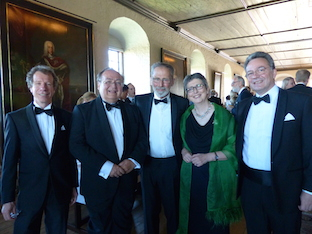Yves Meyer on the Abel Week in Oslo
A report on the three days of celebration for Abel Laureate Yves Meyer in Oslo.
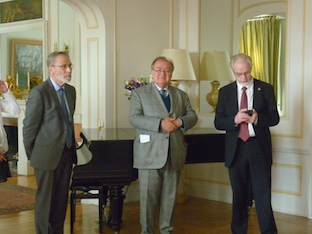
MAY 22nd
On the morning of the 22nd, Meyer was guest of honour at the Holmboe Prize award ceremony, a prize named after Abel's math teacher, which honors excellence in teaching mathematics. After a long interview, he met French high school students on a reception at the French Embassy.
Yves Meyer gave a short unconventional speech in which he apologized for the wrongs France had done to Abel on two occasions, namely the fact that as a consequence of the continental blocus during the Napolean wars, Abel, then a child, contracted tuberculosis, and the more well-known fact that Cauchy did not take into account the famous note that Abel had sent to the Academy of Sciences.
As tradition has it, Yves Meyer then placed a wreath at Gustav Vigeland's Abel Monument in the Palace Park in honour of Abel's genius. It marked the beginning of the official Abel celebration.

May 23rd: second day In Oslo, including the award ceremony

This second day started with the repetition of the award ceremony. The king of Norway then granted Yves Meyer an audience and was particularly interested in the part that the wavelets played in the detection of gravitational waves. At lunchtime, Yves Meyer enjoyed a delicious "Abel cake", which receipe was elaborated by a norwegian mathematician!
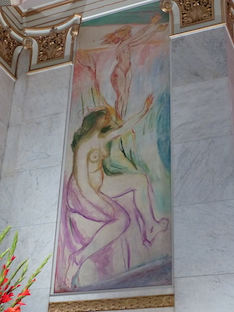
Then took place the core event of this 3-day trip: the award ceremony of the Abel Prize in the "Aula" of the University of Oslo, decorated by Edward Munch. A bigger Abel Fanfare than on the previous day welcomed the laureate!
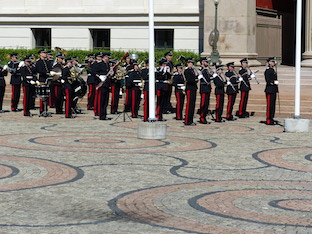
First were delivered a couple of speeches on Yves Meyer's work, one of them by the President of the Norwegian Academy, on Yves Meyer's contribution to the theory of wavelets.
The Abel Prize was awarded to Yves Meyer by King Harald V in person, then the laureate gave a speech of thanks and acknowledgements in which he particularly insisted on the part that his colleagues and pupils played in his research.

Interview
Yves Meyer was then interviewed by a anchorwoman of the Norwegian television, who asked him about his vision of research.
The laureate explained how, as a child in Tunisia, he developed the mind of a nomad, aspiring to go from one problem to another, from place to place, without ever feeling bound anywhere. He also described how he likes doing mathematics, tackling a problem with just bare hands, without being influenced by the existing literature on the subject, and criticized "incremential research", which more and more mathematicians practice, consisting in dedicating all one's life to the same one problem.
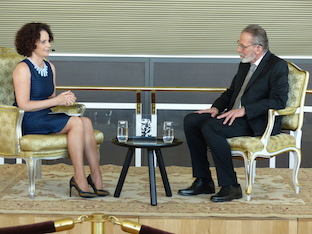
MAY 24th, third day in Oslo: time to do maths!
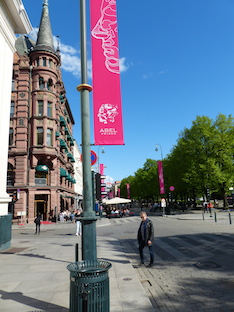
For three days, the main street in Oslo was decked with Abel Prize flags, revealing the importance the Norwegian people attach to the event.
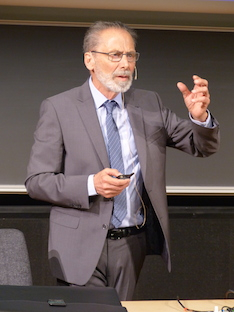
This 3rd day was dedicated to science and Yves Meyer had two talks to deliver!
He delivered the first one in front of a private committee, notably consisting of Norwegian specialists of oil detection. This returned to the roots of the adventure of wavelets, as it started in the early 80s when Jean Morlet invented algorithms to improve the finish on the images of oil detection as obtained by sismic vibration.
The next talk took place in a lecture hall of the University of Oslo. Yves Meyer talked about one of the most recent and popularized applications of wavelets: the part they played in the detection of the first gravitational wave. He started by radically presenting wavelet analysis by saying that it makes up for the limitation of our senses:
More precisely, time-scales wavelets obtained by translation and dilation of the same function make up for the information that our eyes can't see; and time-frequencies wavelets obtained by localisation of the signal on a window and then applying Fourier analysis, make up for the information that our ears can't hear. He went on showing how this motivation finds its roots in the great scientific program that Joseph Fourier launched at the beginning of the 19th century, expressing similar ideas.
After describing the mathematical tools which take part in the gravitational waves detection, he ended up his speech on an impressive 'finale', explaining why the old hierarchy of sciences as Auguste Comte described it, placing mathematics at its top, should now be replaced by the idea of an orchestra in which all scientific disciplines would play and interact in harmony. He answered a question of the audience on the way one can favour interactions between scientific disciplines by pointing out that, to him, research departments of similar, reasonably good size, are the most fit for helping researches of different disciplines come together.
It was then time for Ingrid Daubechies and Stéphane Mallat to make a speech. Both of them were among the first collaborators of the 'wavelet period' of Yves Meyer. Emmanuel Candes, who is younger and lucky to have had Yves Meyer as a teacher at University Paris Dauphine, then testified to Yves Meyer's great impact as a teacher.
All three of them, with different words, described the subtle back-and-forth exchanges between mathematics, physics, signal processing and digital image processing, in which, as the Abel committee put it, Yves Meyer played 'a pivotal role'.

Ingrid Daubechies ended her talk by stating another recent, stunning application of wavelets. Take the Annunciation of the Ghent Altarpiece "Adoration of the Mystic Lamb": methods using wavelets (among other methods) allowed to spell out the page of the half-open book painted in the scene and to spot that it was a text by St Thomas d'Aquin about Annunciation.
Between each talk, a short, lively film on Yves Meyer was played. In particular, the laureate reminds the mathematicians they should stay modest: "Mathematicians have a tendency to believe that they know the truth about everything outside mathematics, which is a little bit ridiculous".
